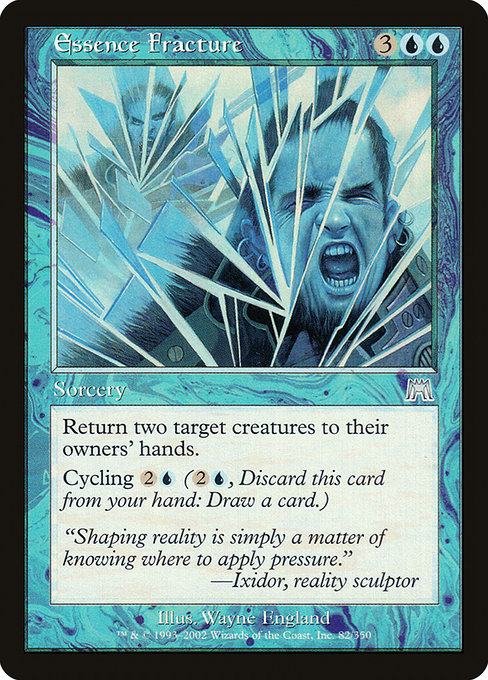
Image courtesy of Scryfall.com
Optimal Combos with Essence Fracture, Guided by AI
In the ever-evolving dance of MTG strategy, you don’t just play cards—you train a mind to navigate tempo, value, and disruption. When you feed a card like Essence Fracture into an AI-assisted optimization process, the results aren’t just “good enough.” They surface paths through blue control that balance two core levers: tempo via bounce and card advantage via cycling. Essence Fracture is a blue sorcery from Onslaught (set type expansion, uncommon) that costs 3UU and reads: Return two target creatures to their owners’ hands. Cycling for 2U lets you discard this card to draw a card, adding another layer of flexibility to a deck built around decision points each turn. This combination of bounce and draw power is a playground for AI to explore, especially in Commander-legal and Legacy contexts where you can lean into predictable board states and resilient blue tools. 🧙♂️🔥
The AI’s knack here is to weigh the timing of Essence Fracture against your opponent’s likely targets, your own board presence, and the cadence of your cantrips and permission spells. With two targets to bounce, you can: slow down an early rush, reset a problematic deployment, or prematurely empty an opponent’s board of key threats—then reset the tempo by cycling and drawing into fresh control. The flavor text of the card—“Shaping reality is simply a matter of knowing where to apply pressure.” —Ixidor, reality sculptor—reads like a blueprint for AI-guided play: pressure is most effective when applied where your opponent least expects it, and Essence Fracture gives you two pressure points in a single move. ⚡️
Core AI-Recommended Angles
- Tempo plays followed by cantrip cadence — Cast Essence Fracture early to push two opposing threats back to hand, buying a precious window to deploy your own plan. Then cycle to replenish cards, ensuring you don’t stall out. The AI tends to favor sequences that maximize information gain per mana, which in practice means pairing this bounce with cheap cantrips and cheap counterspells to maintain pressure. 🧙♂️
- Blitz-freeze cycles — In many blue shells, a cycle engine that draws into select answers (counterspells, bounce, or direct draw) lets you stabilize after a two-for-one. Essence Fracture becomes a tempo-finisher when you’ve established a rhythm of drawing into early answers and then using cycling to refill your hand after each bounce. The AI’s suggested lines often incorporate a mix of draw-rich blue cantrips and resilient permission suite to lock down turns after you bounce two threats. 🎲
- Target prioritization and value sizing — When choosing which two creatures to bounce, the AI tends to prioritize high-impact threats (contestants with big bodies or important activated abilities) and those that unlock opponent strategies on entry. The ability to pick two targets means you can disrupt two different lines of play in one move, which is especially potent in multiplayer Commander where board states shift rapidly. Keep in mind the cycling option—sometimes discarding Essence Fracture to draw the next line of control is precisely the right move. 💎
- Synergy with blue recursion and blink ecosystems — The AI loves decks that can rebounce or recast spells through flicker or graveyard interaction. While Essence Fracture itself is a one-shot effect, pairing it with cards that recur or re-play your removal and draw spells can turn the cycling ability into ongoing pressure—without getting tangled in over-committing to one trick. In practice, look for ways to re-use your resources across turns, not just in a single sequence. 🧙♂️
- Commander-friendly tempo control — In EDH/Commander, Essence Fracture shines as flexible disruption that can swing tempo against a wide board. The AI will flag lines where you hold up mana for counters while planning to bounce two threats the moment you’re sure you can weather the counter-war. In longer games, those two bounced creatures can dramatically tilt the mid-to-late game — especially when you’ve also drawn into a solid package of card draw and permission. ⚔️
From a design perspective, Essence Fracture embodies a classic Blue approach: tempo via knowledge and disruption paired with options for card draw. The Onslaught-era flavor text hints at reality’s malleability when you know where to apply pressure, and AI-augmented planning helps you translate that theory into tight, reproducible playlines. The card’s mana cost (3UU) and its cycling cost (2U for a draw) intentionally encourage a plan that accesses multiple lines of play: a two-creature bounce on one turn, then a draw-discard cycle to refill your hand for the next. In practice, you’ll want to weave Essence Fracture into a deck that includes solid permission (counterspells), efficient card draw, and a few recursion or flicker options to keep your control suite alive across games. For players who enjoy the dance of tempo and tempo-based decisions, this card provides a reliable lever. And yes, AI can help you tune target selection and timing, but a human touch—anticipating opponents’ boards and possible recurrences—remains essential. 🎨
“Shaping reality is simply a matter of knowing where to apply pressure.” — Ixidor, reality sculptor
If you’re curious about how AI-curated optimals would look in a modern blue-heavy shell, this card is a perfect test case: it’s not a flashy combo piece that pivots a game on a single interaction, but a reliable engine piece that enables smarter tempo through intelligent target selection and cycling decisions. And if you’re browsing for a little real-world inspiration while testing these ideas, the cross-promotional product below makes a great companion for your MTG sessions—stylish, sturdy, and ready for longer play nights. 🧙♂️💎
Card Holder Phone Case with MagSafe Polycarbonate Glossy or MatteMore from our network
- https://blog.digital-vault.xyz/blog/post/rix-maadi-guildmage-tracing-mtg-keyword-evolution/
- https://blog.digital-vault.xyz/blog/post/how-digital-paper-transforms-architectural-presentation-boards/
- https://blog.digital-vault.xyz/blog/post/technical-writing-essentials-for-startup-teams/
- https://transparent-paper.shop/blog/post/how-to-create-realistic-creases-on-digital-paper/
- https://blog.digital-vault.xyz/blog/post/rain-of-tears-cross-format-design-constraints-unveiled/